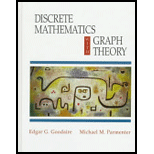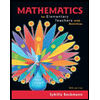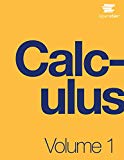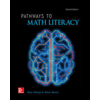
Discrete Mathematics with Graph Theory (Classic Version) (3rd Edition) (Pearson Modern Classics for Advanced Mathematics Series)
3rd Edition
ISBN: 9780134689555
Author: Edgar Goodaire, Michael Parmenter
Publisher: PEARSON
expand_more
expand_more
format_list_bulleted
Question
Chapter 12.1, Problem 13E
To determine
The number of vertices of degree 2. If a tree has 100 vertices of degree 1 and 20 of degree 6 and that one-half of the remaining vertices are degree 4 and the rest of degree 2.
To determine
To prove: A tree has the vertices of degree 1 must be less than 80 cannot exist except as specified in part (a).
Expert Solution & Answer
Want to see the full answer?
Check out a sample textbook solution
Students have asked these similar questions
(b) A planar graph has 10 edges and its dual graph has j edges, for some integer j.
What is this j?
Answer: j =
(a) Is there an undirected graph with 7 vertices such that five of the vertices have degree 3
and the remaining two have degree 4? If yes, then draw the graph and if not, then prove
your answer.
In the following, let T denote a full 3-ary (rooted) tree with 25 vertices. Justify your answers
co the questions below.
(b) Find the number of internal vertices (denote it by i) and the number of leaves of T (denote
it by l).
(c) What is the minimum possible height for T?
(d) If T is balanced, then what is the height of T?
(a) Is there an undirected graph with 7 vertices such that five of the vertices have degree 3
and the remaining two have degree 4? If yes, then draw the graph and if not, then prove
your answer.
In the following, let T denote a full 3-ary (rooted) tree with 25 vertices. Justify your answers
to the questions below.
(b) Find the number of internal vertices (denote it by i) and the number of leaves of T (denote
it by l).
(c) What is the minimum possible height for T?
(d) If T is balanced, then what is the height of T?
Chapter 12 Solutions
Discrete Mathematics with Graph Theory (Classic Version) (3rd Edition) (Pearson Modern Classics for Advanced Mathematics Series)
Ch. 12.1 - Prob. 1TFQCh. 12.1 - Prob. 2TFQCh. 12.1 - Prob. 3TFQCh. 12.1 - Prob. 4TFQCh. 12.1 - Prob. 5TFQCh. 12.1 - Prob. 6TFQCh. 12.1 - Prob. 7TFQCh. 12.1 - Prob. 8TFQCh. 12.1 - Prob. 9TFQCh. 12.1 - Prob. 10TFQ
Ch. 12.1 - Prob. 1ECh. 12.1 - Prob. 2ECh. 12.1 - Prob. 3ECh. 12.1 - Prob. 4ECh. 12.1 - Prob. 5ECh. 12.1 - Prob. 6ECh. 12.1 - Prob. 7ECh. 12.1 - Prob. 8ECh. 12.1 - 9. The vertices in the graph represent town; the...Ch. 12.1 - Prob. 11ECh. 12.1 - 12. [BB] suppose and are two paths from a vertex...Ch. 12.1 - Prob. 13ECh. 12.1 - Prob. 14ECh. 12.1 - Prob. 15ECh. 12.1 - Prob. 16ECh. 12.1 - 17. [BB] Recall that a graph is acyclic if it has...Ch. 12.1 - Prob. 18ECh. 12.1 - Prob. 19ECh. 12.1 - Prob. 20ECh. 12.1 - Prob. 21ECh. 12.1 - Prob. 22ECh. 12.1 - The answers to exercises marked [BB] can be found...Ch. 12.1 - Prob. 24ECh. 12.1 - Prob. 25ECh. 12.1 - A forest is a graph every component of which is a...Ch. 12.1 - Prob. 27ECh. 12.2 - Prob. 1TFQCh. 12.2 - Prob. 2TFQCh. 12.2 - Prob. 3TFQCh. 12.2 - Prob. 4TFQCh. 12.2 - Prob. 5TFQCh. 12.2 - Prob. 6TFQCh. 12.2 - Prob. 7TFQCh. 12.2 - Prob. 8TFQCh. 12.2 - Prob. 9TFQCh. 12.2 - Prob. 1ECh. 12.2 - Prob. 2ECh. 12.2 - Prob. 3ECh. 12.2 - Prob. 4ECh. 12.2 - Prob. 5ECh. 12.2 - Prob. 6ECh. 12.2 - Prob. 7ECh. 12.2 - Prob. 8ECh. 12.2 - Prob. 9ECh. 12.2 - Prob. 10ECh. 12.2 - Prob. 11ECh. 12.2 - Prob. 12ECh. 12.2 - Prob. 13ECh. 12.2 - Prob. 14ECh. 12.2 - Prob. 15ECh. 12.2 - Prob. 16ECh. 12.2 - Prob. 17ECh. 12.3 - If Kruskal’s algorithm is applied to after one...Ch. 12.3 - 2. If Kruskal’s algorithm is applied to we might...Ch. 12.3 - 3. If Kruskal’s algorithm is applied to we might...Ch. 12.3 - If Prim’s algorithm is applied to after one...Ch. 12.3 - If Prims algorithm is applied to we might end up...Ch. 12.3 - If Prims algorithm is applied to we might end up...Ch. 12.3 - Prob. 7TFQCh. 12.3 - Prob. 8TFQCh. 12.3 - Prob. 9TFQCh. 12.3 - Prob. 10TFQCh. 12.3 - Prob. 1ECh. 12.3 - Prob. 2ECh. 12.3 - Prob. 3ECh. 12.3 - Prob. 4ECh. 12.3 - The answers to exercises marked [BB] can be found...Ch. 12.3 - Prob. 6ECh. 12.3 - Prob. 7ECh. 12.3 - Prob. 8ECh. 12.3 - Prob. 9ECh. 12.3 - Prob. 10ECh. 12.3 - Prob. 11ECh. 12.3 - In our discussion of the complexity of Kruskals...Ch. 12.3 - Prob. 13ECh. 12.3 - Prob. 14ECh. 12.3 - Prob. 15ECh. 12.3 - Prob. 16ECh. 12.3 - Prob. 17ECh. 12.3 - Prob. 18ECh. 12.4 - The digraph pictured by is a cyclic.Ch. 12.4 - Prob. 2TFQCh. 12.4 - Prob. 3TFQCh. 12.4 - Prob. 4TFQCh. 12.4 - Prob. 5TFQCh. 12.4 - Prob. 6TFQCh. 12.4 - Prob. 7TFQCh. 12.4 - Prob. 8TFQCh. 12.4 - Prob. 9TFQCh. 12.4 - Prob. 10TFQCh. 12.4 - Prob. 1ECh. 12.4 - Prob. 2ECh. 12.4 - Prob. 3ECh. 12.4 - Prob. 4ECh. 12.4 - 5. The algorithm described in the proof of...Ch. 12.4 - How many shortest path algorithms can you name?...Ch. 12.4 - Prob. 7ECh. 12.4 - Prob. 8ECh. 12.4 - Prob. 10ECh. 12.4 - Prob. 11ECh. 12.4 - Prob. 12ECh. 12.4 - [BB] Explain how Bellmans algorithm can be...Ch. 12.4 - Prob. 14ECh. 12.5 - Prob. 1TFQCh. 12.5 - Depth-first search has assigned labels 1 and 2 as...Ch. 12.5 - Depth-first search has assigned labels 1 and 2 as...Ch. 12.5 - Prob. 4TFQCh. 12.5 - Prob. 5TFQCh. 12.5 - Prob. 6TFQCh. 12.5 - Prob. 7TFQCh. 12.5 - Prob. 8TFQCh. 12.5 - 9. Breadth-first search (see exercise 10) has...Ch. 12.5 - Prob. 10TFQCh. 12.5 - Prob. 1ECh. 12.5 - Prob. 2ECh. 12.5 - Prob. 3ECh. 12.5 - 4. (a) [BB] Let v be a vertex in a graph G that is...Ch. 12.5 - Prob. 5ECh. 12.5 - Prob. 6ECh. 12.5 - Prob. 7ECh. 12.5 - Prob. 8ECh. 12.5 - Prob. 9ECh. 12.5 - Prob. 10ECh. 12.5 - [BB; (a)] Apply a breath-first search to each of...Ch. 12.5 - Prob. 12ECh. 12.5 - Prob. 13ECh. 12.5 - Prob. 14ECh. 12.6 - Prob. 1TFQCh. 12.6 - Prob. 2TFQCh. 12.6 - Prob. 3TFQCh. 12.6 - Prob. 4TFQCh. 12.6 - Prob. 5TFQCh. 12.6 - Prob. 6TFQCh. 12.6 - Prob. 7TFQCh. 12.6 - Prob. 8TFQCh. 12.6 - Prob. 9TFQCh. 12.6 - Prob. 10TFQCh. 12.6 - Prob. 1ECh. 12.6 - Prob. 2ECh. 12.6 - Prob. 3ECh. 12.6 - Prob. 4ECh. 12.6 - Prob. 5ECh. 12.6 - Prob. 6ECh. 12.6 - Prob. 7ECh. 12.6 - Prob. 8ECh. 12.6 - Prob. 9ECh. 12.6 - Prob. 10ECh. 12.6 - Prob. 11ECh. 12.6 - Prob. 12ECh. 12.6 - Prob. 13ECh. 12.6 - Prob. 14ECh. 12.6 - Prob. 15ECh. 12 - Prob. 1RECh. 12 - Prob. 2RECh. 12 - Prob. 3RECh. 12 - Prob. 4RECh. 12 - 5. (a) Let G be a graph with the property that...Ch. 12 - Prob. 6RECh. 12 - Prob. 7RECh. 12 - Prob. 8RECh. 12 - Prob. 9RECh. 12 - Prob. 10RECh. 12 - Prob. 11RECh. 12 - Prob. 12RECh. 12 - Prob. 13RECh. 12 - Prob. 14RECh. 12 - Prob. 15RECh. 12 - Prob. 16RECh. 12 - Prob. 17RECh. 12 - Prob. 18RECh. 12 - In each of the following graphs, a depth-first...Ch. 12 - Prob. 20RECh. 12 - Prob. 21RECh. 12 - Prob. 22RECh. 12 - Prob. 23RECh. 12 - Prob. 24RECh. 12 - Prob. 25RECh. 12 - Prob. 26RE
Knowledge Booster
Learn more about
Need a deep-dive on the concept behind this application? Look no further. Learn more about this topic, subject and related others by exploring similar questions and additional content below.Similar questions
- Use the theorem that relates the sum of degrees to the number of edges to determine the number of edges in the graph (without drawing the graph). A graph with 16 vertices, 7 of degree 1, 4 of degree 2, and 5 of degree 3 This graph must have edges. ...arrow_forwardExplain why the two graphs in Fig. 1.23 are not isomorphic.arrow_forwardProve that the two graphs below are isomorphic. (c) Figure 4: Two undirected graphs. Each graph has 6 vertices. The ver- tices in the first graph are arranged in two rows and 3 columns. From left to right, the vertices in the top row are 1, 2, and 3. From left to right, the vertices in the bottom row are 6, 5, and 4. Undirected edges, line segments, are between the following vertices: 1 and 2; 2 and 3; 1 and 5; 2 and 5; 5 and 3; 2 and 4; 3 and 6; 6 and 5; and 5 and 4. The vertices in the second graph are a through f. Vertices d, a, and c, are vertically inline. Vertices e, f, and b, are horizontally to the right of vertices d, a, and c, respectively. Undirected edges, line segments, are between the following vertices: a and d; a and c; a and e; a and b; d and b; a and f; e and f; c and f; and b and f.arrow_forward
- Let G₁ and G₂ be two distinct trees with the same vertex-set V. Prove that d(G₁)=d(G₂) if (G₁-x) = (G₂-x) for any x EV.arrow_forwardConsider any table with 2 rows and n − 1 columns; the first row holds 1, 2, 3,...,n − 1; the second row holds arbitrary numbers between 1 and n. Construct a graph on nodes labeled 1,...,n by connecting the two nodes in each column of our table. (a) Show by an example that this graph is not always a tree. (b) Prove that if the graph is connected, then it is a tree. (c) Prove that every connected component of this graph contains at most one cycle.arrow_forwardIf G1 and G2 are isomorphic, must they have the same number of vertices? If G1 and G2 have the same number of vertices must they be isomorphic? If not, give an example.arrow_forward
- 9. AABC has vertices A(-6, 6), B(6, 6), and (-6, –2). Which graph shows the image of AABC after a dilation with scale factor and center of dilation at point A, followed by a translation of 8 units horizontally and -8 units vertically? (Note: the coordinate grid is counting by 2.) А. C. В. D.arrow_forwardProve that the two graphs below are isomorphic Figure 4: Two undirected graphs. Each graph has 6 vertices. The vertices in the first graph are arranged in two rows and 3 columns. From left to right, the vertices in the top row are 1, 2, and 3. From left to right, the vertices in the bottom row are 6, 5, and 4. Undirected edges, line segments, are between the following vertices: 1 and 2; 2 and 3; 1 and 5; 2 and 5; 5 and 3; 2 and 4; 3 and 6; 6 and 5; and 5 and 4. The vertices in the second graph are a through f. Vertices d, a, and c, are vertically inline. Vertices e, f, and b, are horizontally to the right of vertices d, a, and c, respectively. Undirected edges, line segments, are between the following vertices: a and d; a and c; a and e; a and b; d and b; a and f; e and f; c and f; and b and f.arrow_forwardDetermine which symmetries the graph of 3x + the equetion 2xy² = 1 has.arrow_forward
- Consider the tree diagram. Path number 1 B1 C2 2 1 1 3 B2 3 C2 1 5 4 3. B3 C2 C3 7 Find P(C,|B2) · P(B2). (Enter your answer as a fraction.) 151/4arrow_forward(c) Prove that the two graphs below are isomorphic. Figure 4: Two undirected graphs. Each graph has 6 vertices. The ver- tices in the first graph are arranged in two rows and 3 columns. From left to right, the vertices in the top row are 1, 2, and 3. From left to right, the vertices in the bottom row are 6, 5, and 4. Undirected edges, line segments, are between the following vertices: 1 and 2; 2 and 3; 1 and 5; 2 and 5; 5 and 3; 2 and 4; 3 and 6; 6 and 5; and 5 and 4. The vertices in the second graph are a through f. Vertices d, a, and c, are vertically inline. Vertices e, f, and b, are horizontally to the right of vertices d, a, and c, respectively. Undirected edges, line segments, are between the following vertices: a and d; a and c; a and e; a and b; d and b; a and f; e and f; c and f; and b and f. (d) Show that the pair of graphs are not isomorphic by showing that there is a property that is preserved under isomorphism which one graph has and the other does not. Figure 5: Two…arrow_forward
arrow_back_ios
arrow_forward_ios
Recommended textbooks for you
 Discrete Mathematics and Its Applications ( 8th I...MathISBN:9781259676512Author:Kenneth H RosenPublisher:McGraw-Hill Education
Discrete Mathematics and Its Applications ( 8th I...MathISBN:9781259676512Author:Kenneth H RosenPublisher:McGraw-Hill Education Mathematics for Elementary Teachers with Activiti...MathISBN:9780134392790Author:Beckmann, SybillaPublisher:PEARSON
Mathematics for Elementary Teachers with Activiti...MathISBN:9780134392790Author:Beckmann, SybillaPublisher:PEARSON
 Thinking Mathematically (7th Edition)MathISBN:9780134683713Author:Robert F. BlitzerPublisher:PEARSON
Thinking Mathematically (7th Edition)MathISBN:9780134683713Author:Robert F. BlitzerPublisher:PEARSON Discrete Mathematics With ApplicationsMathISBN:9781337694193Author:EPP, Susanna S.Publisher:Cengage Learning,
Discrete Mathematics With ApplicationsMathISBN:9781337694193Author:EPP, Susanna S.Publisher:Cengage Learning, Pathways To Math Literacy (looseleaf)MathISBN:9781259985607Author:David Sobecki Professor, Brian A. MercerPublisher:McGraw-Hill Education
Pathways To Math Literacy (looseleaf)MathISBN:9781259985607Author:David Sobecki Professor, Brian A. MercerPublisher:McGraw-Hill Education

Discrete Mathematics and Its Applications ( 8th I...
Math
ISBN:9781259676512
Author:Kenneth H Rosen
Publisher:McGraw-Hill Education

Mathematics for Elementary Teachers with Activiti...
Math
ISBN:9780134392790
Author:Beckmann, Sybilla
Publisher:PEARSON


Thinking Mathematically (7th Edition)
Math
ISBN:9780134683713
Author:Robert F. Blitzer
Publisher:PEARSON

Discrete Mathematics With Applications
Math
ISBN:9781337694193
Author:EPP, Susanna S.
Publisher:Cengage Learning,

Pathways To Math Literacy (looseleaf)
Math
ISBN:9781259985607
Author:David Sobecki Professor, Brian A. Mercer
Publisher:McGraw-Hill Education
Graph Theory: Euler Paths and Euler Circuits; Author: Mathispower4u;https://www.youtube.com/watch?v=5M-m62qTR-s;License: Standard YouTube License, CC-BY
WALK,TRIAL,CIRCUIT,PATH,CYCLE IN GRAPH THEORY; Author: DIVVELA SRINIVASA RAO;https://www.youtube.com/watch?v=iYVltZtnAik;License: Standard YouTube License, CC-BY